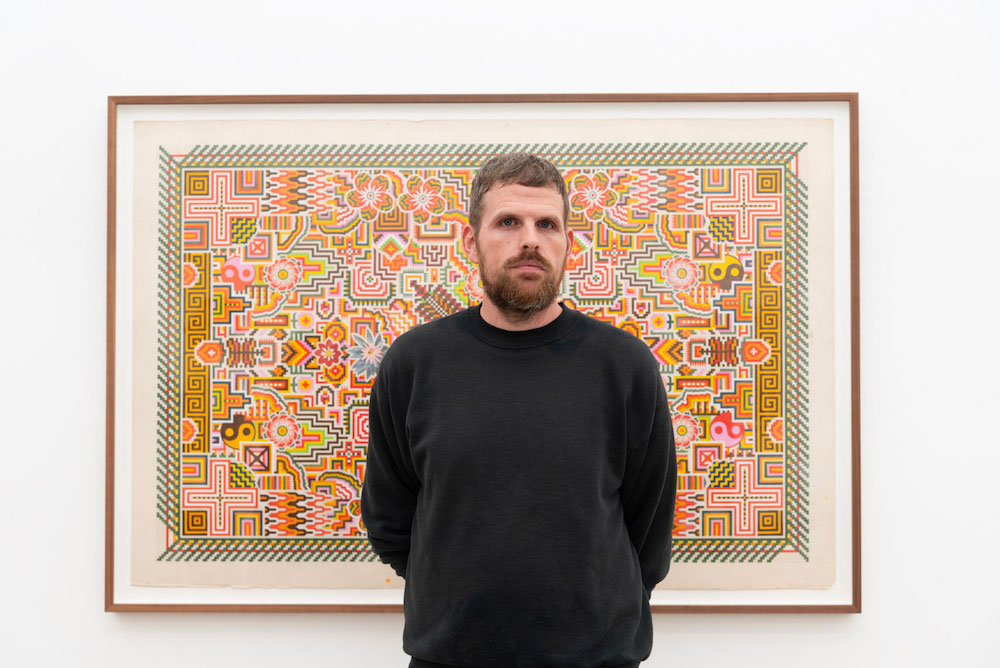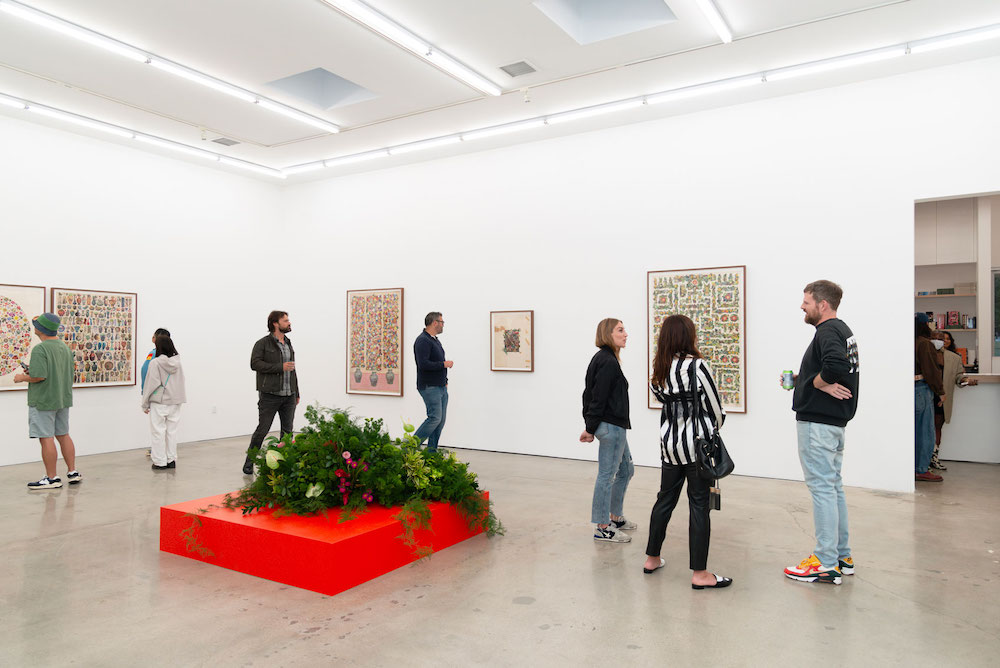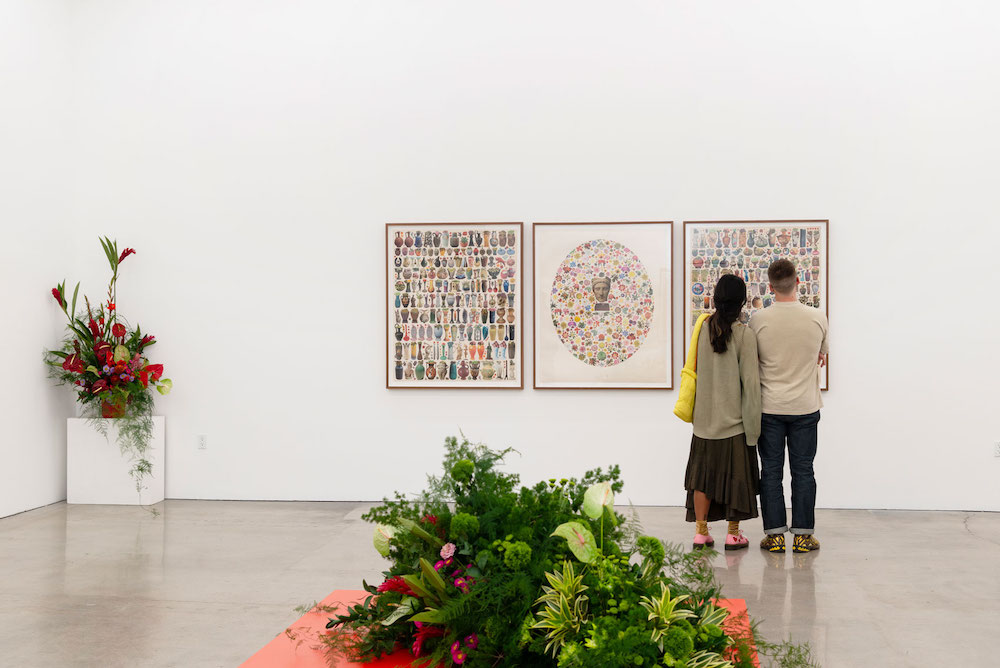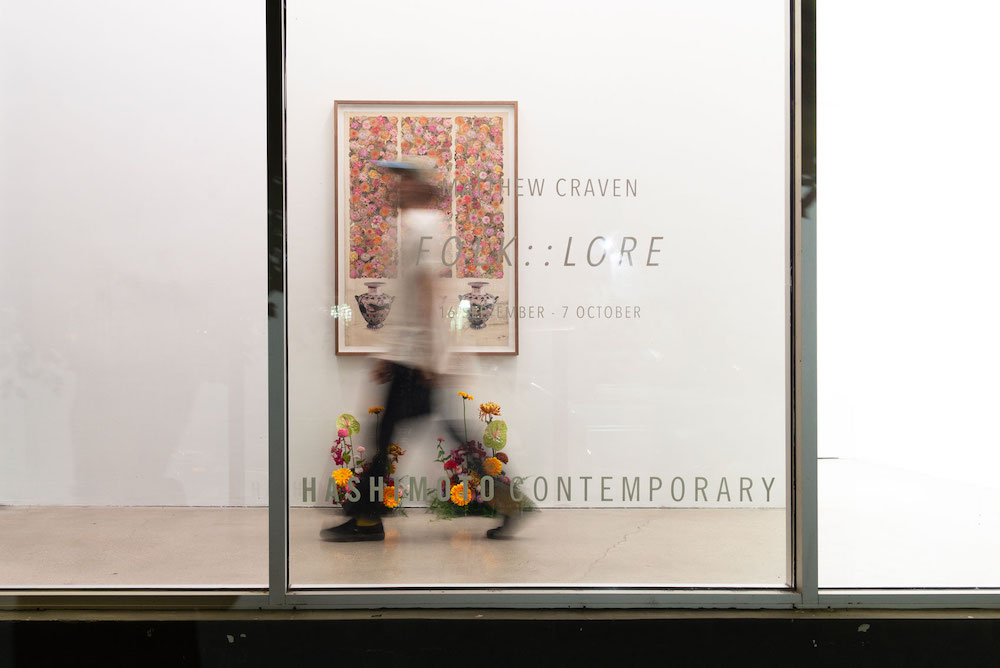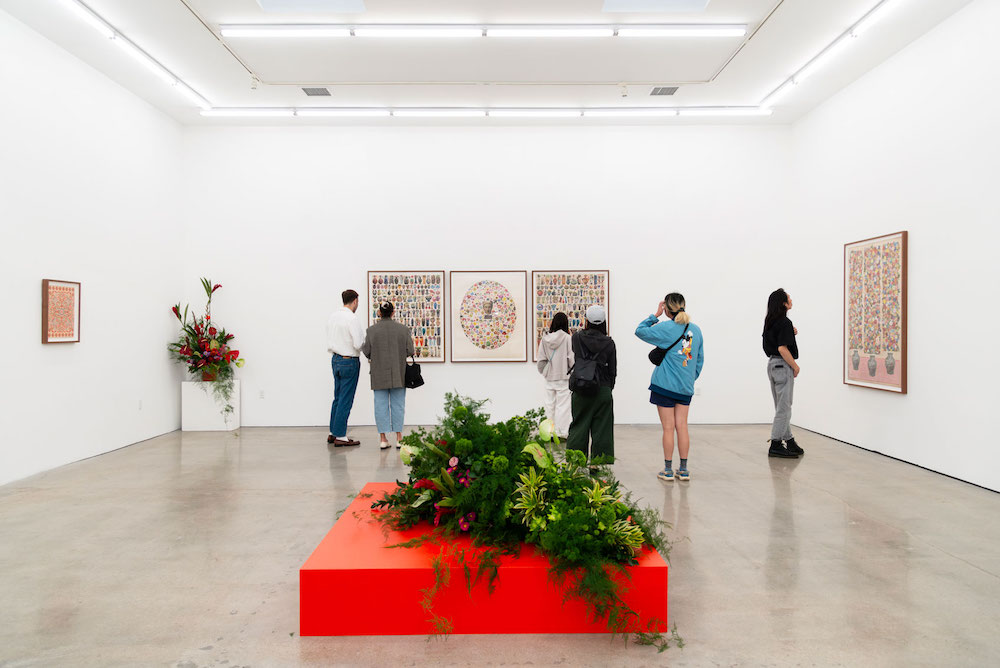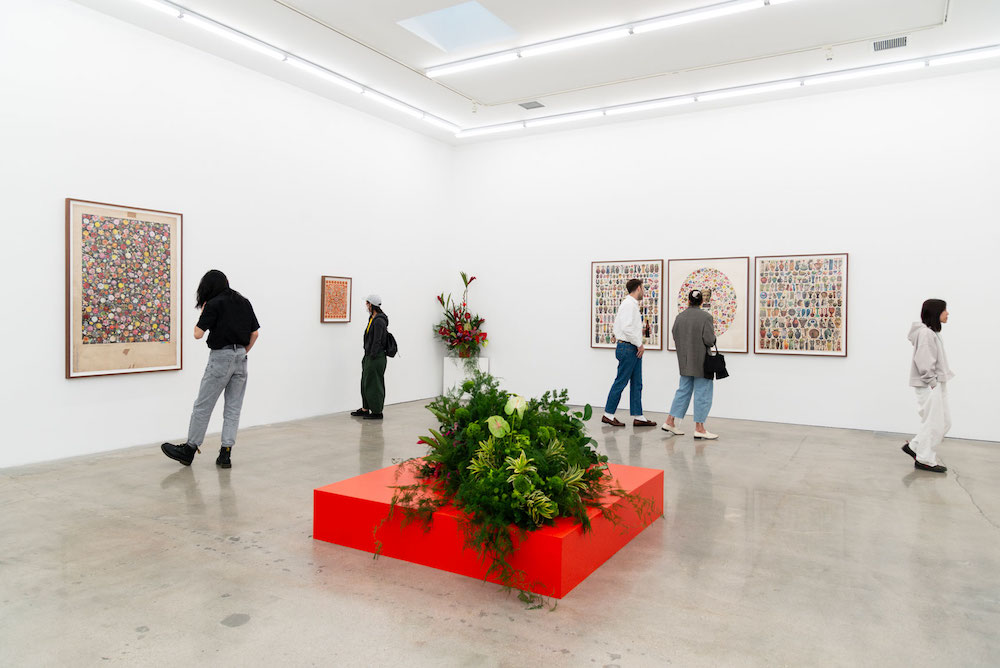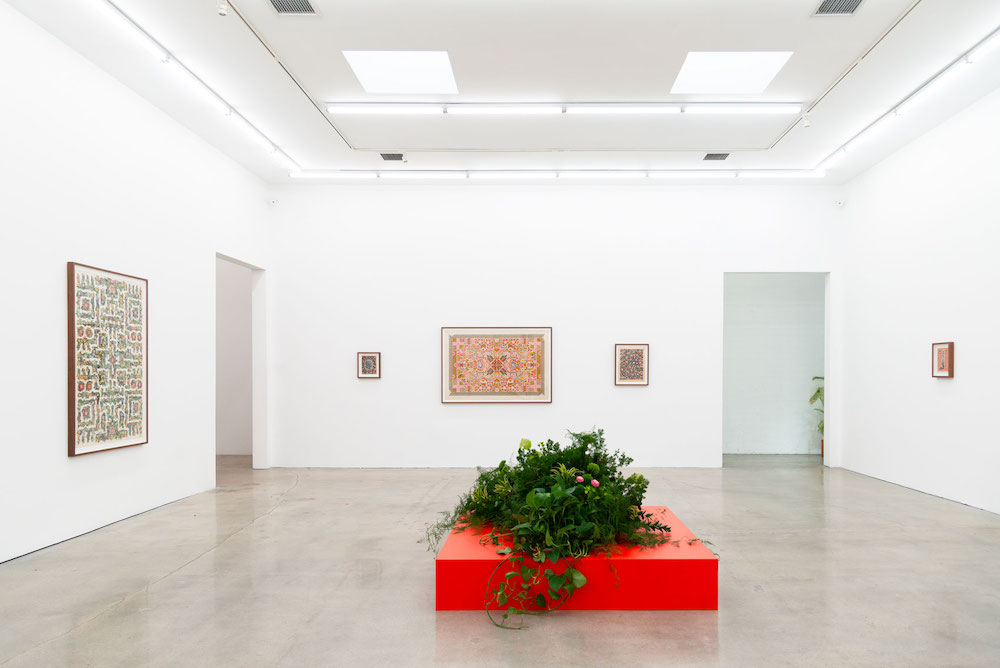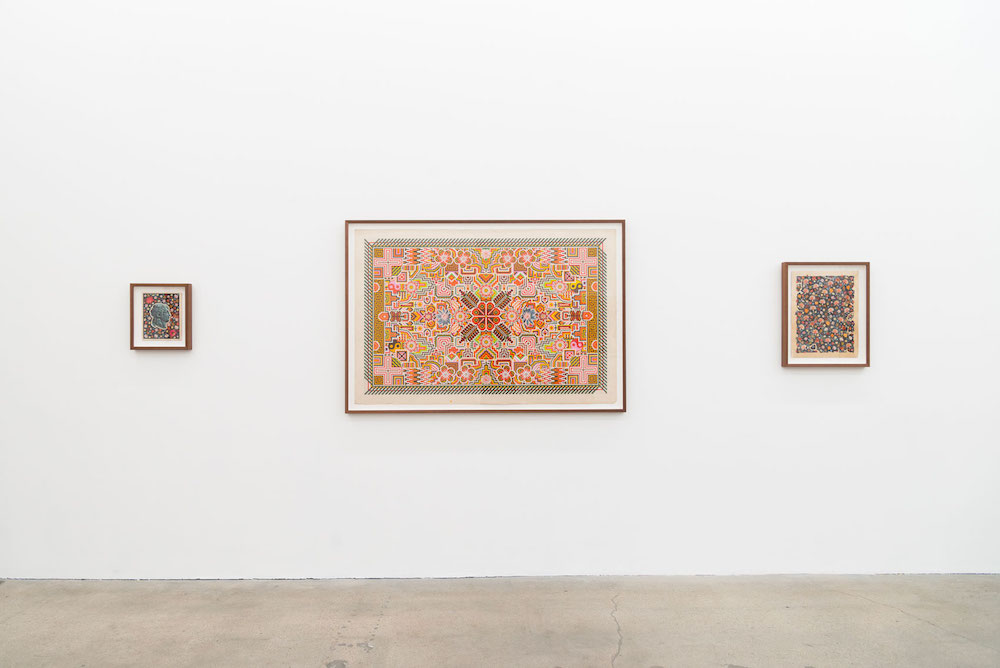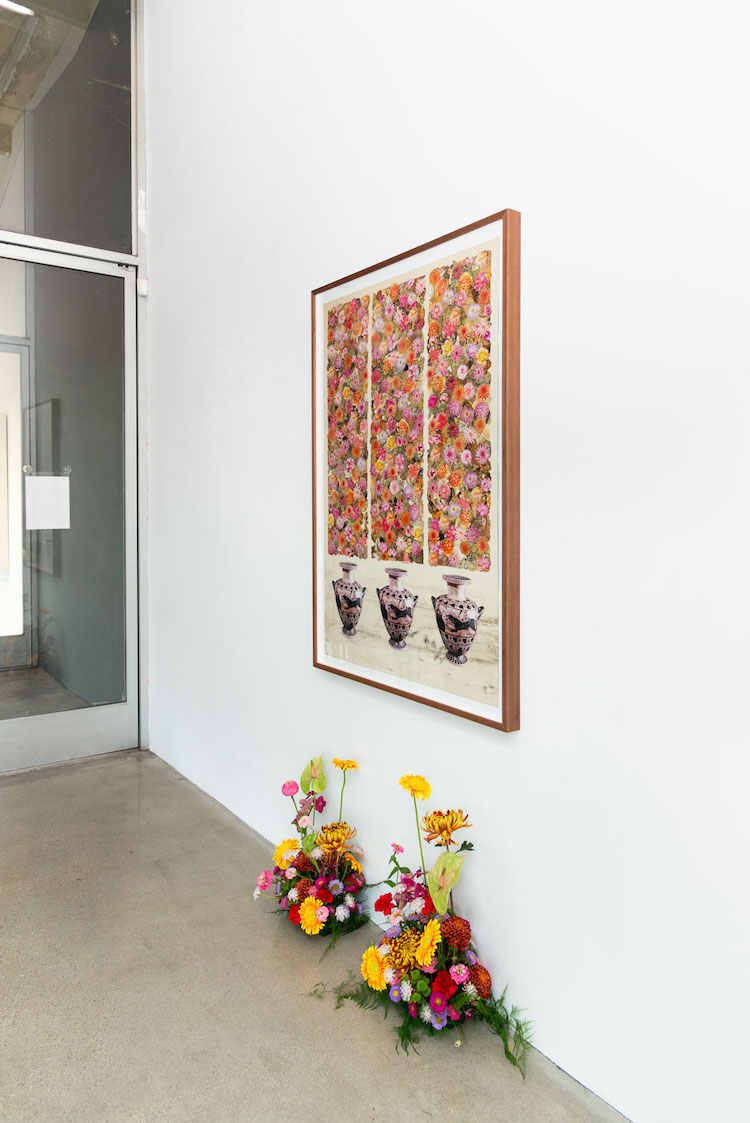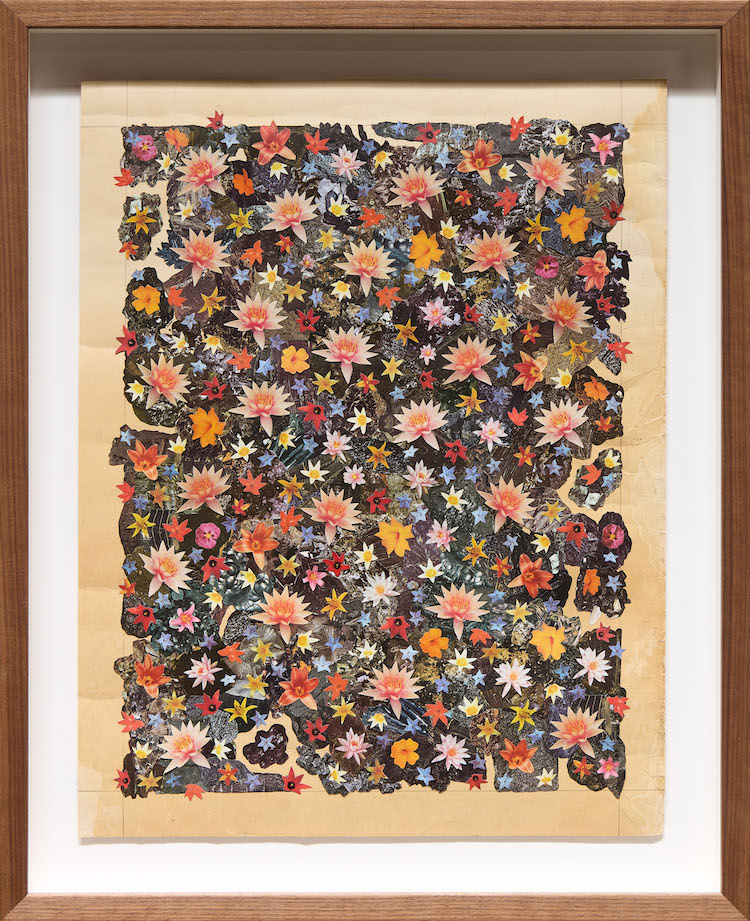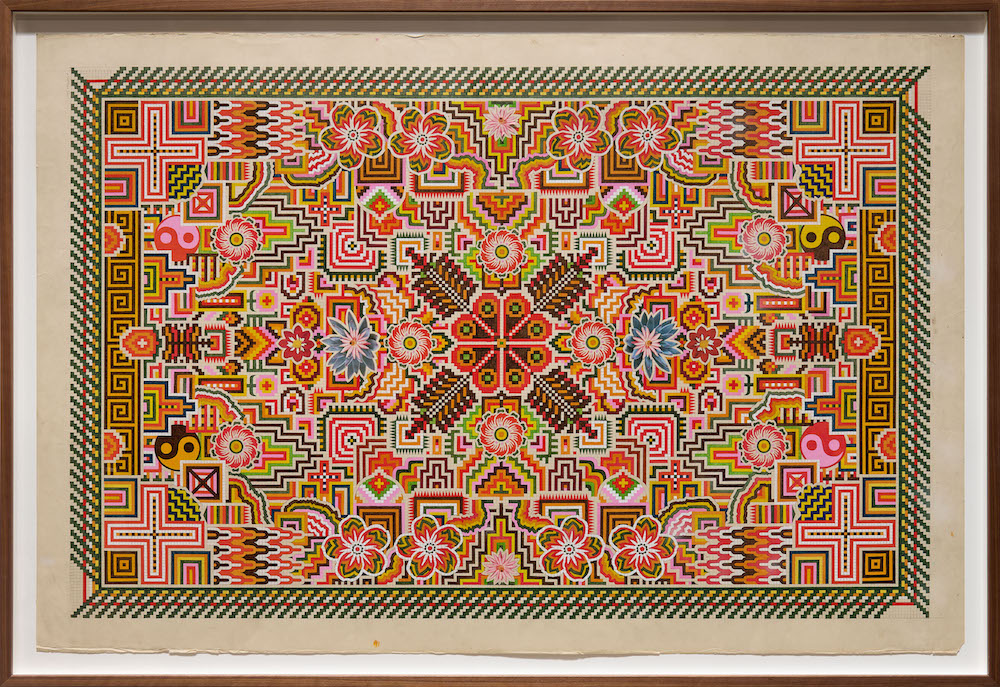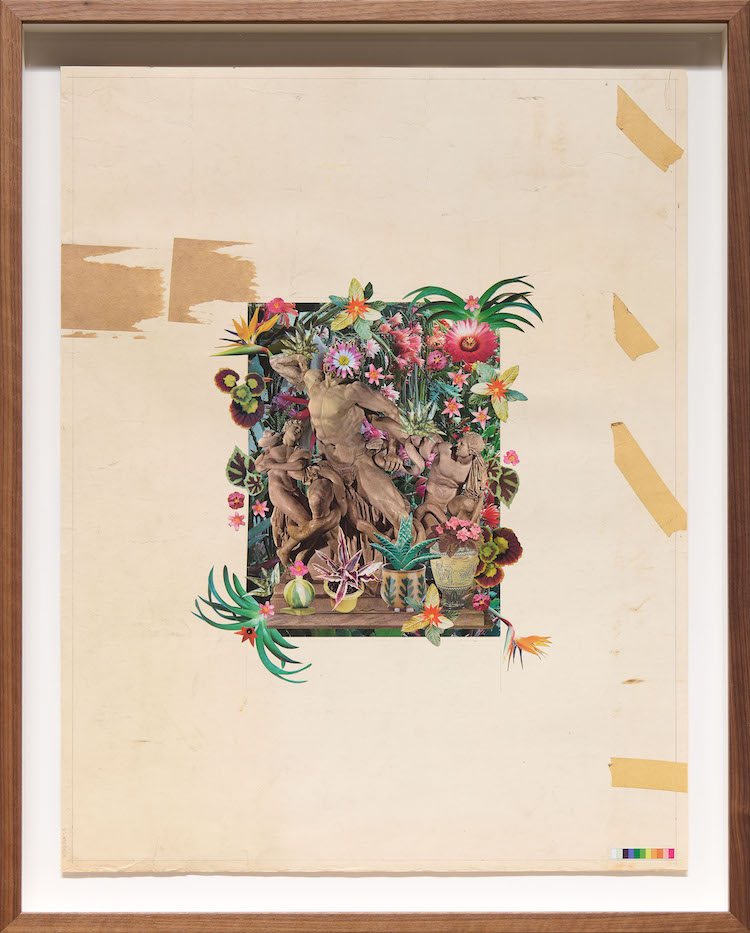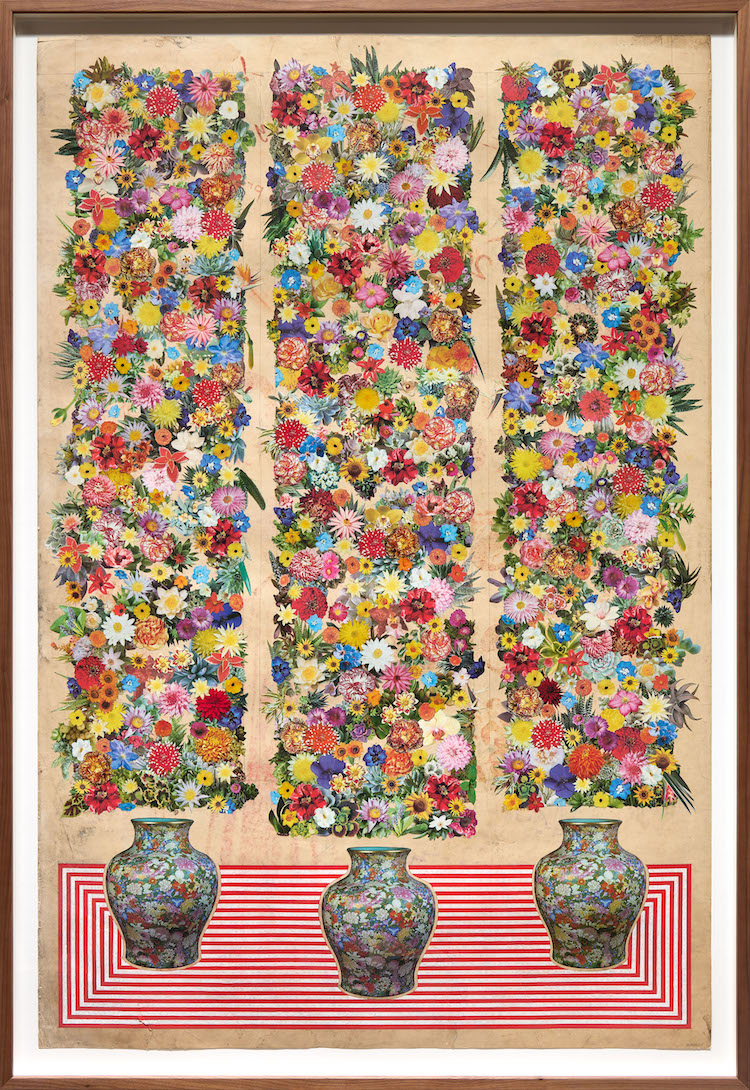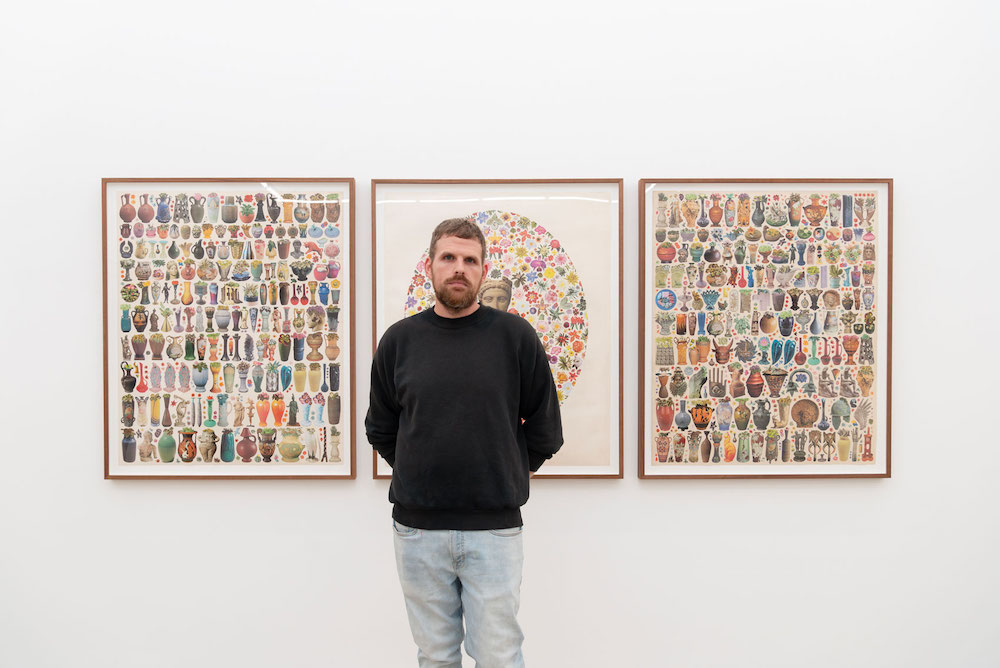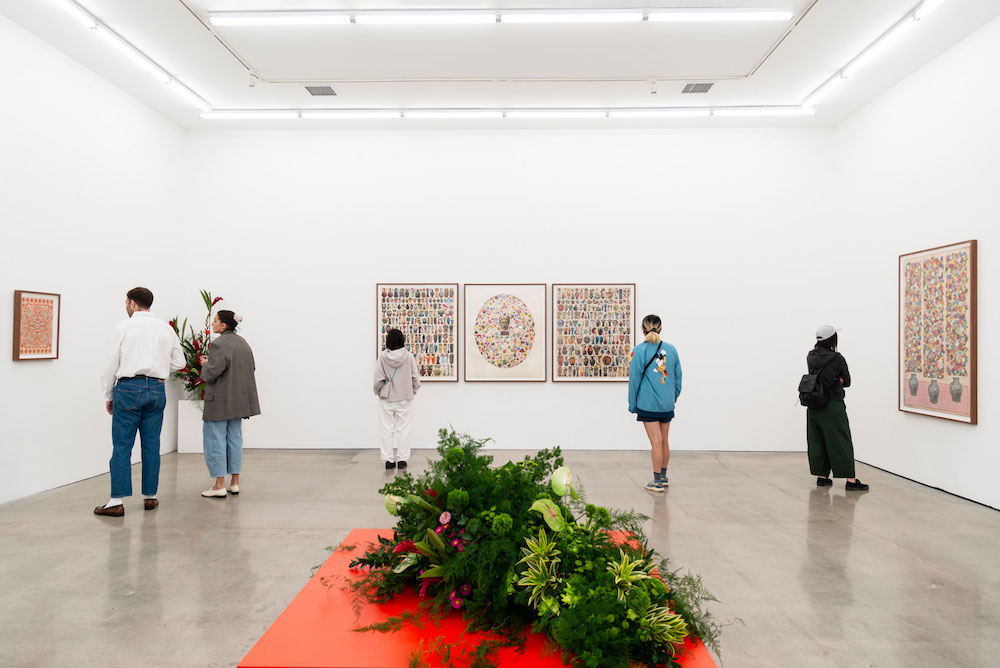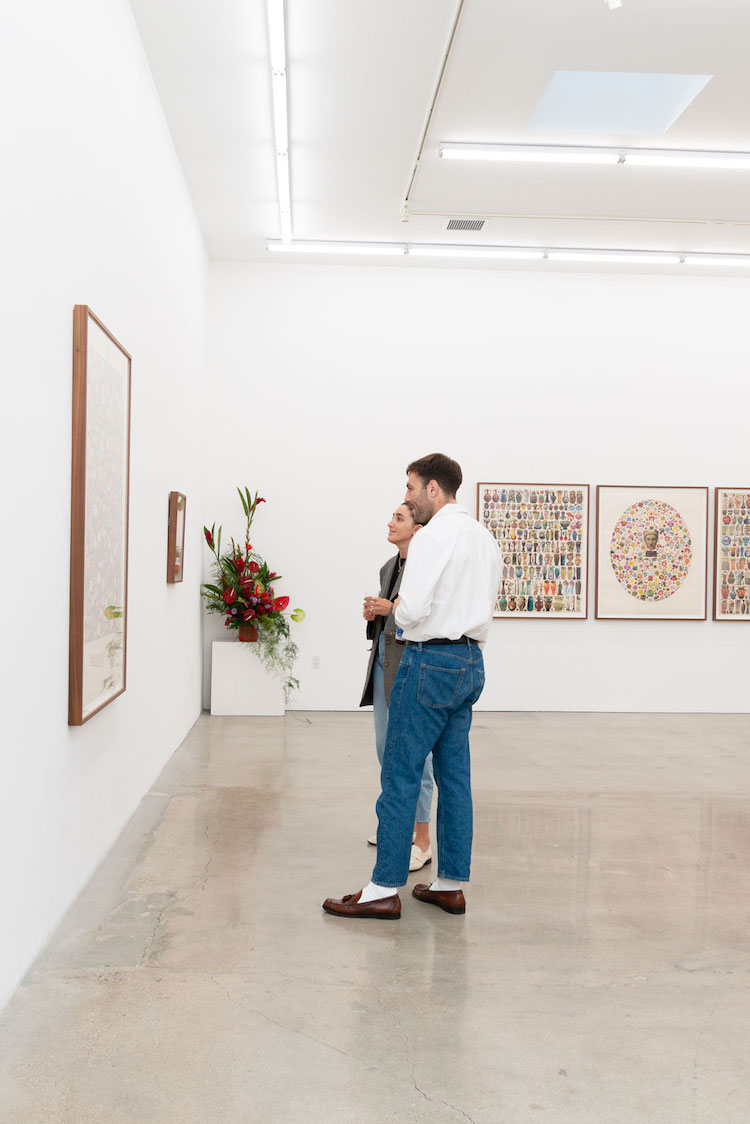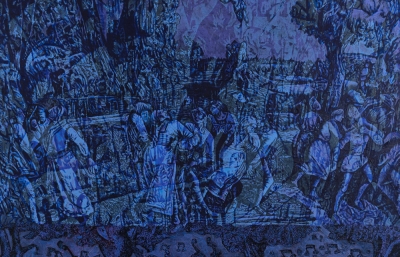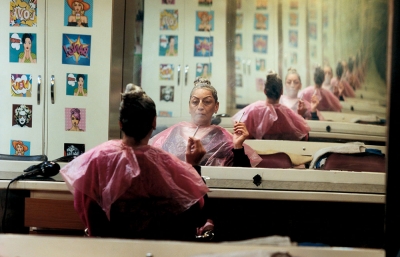Oakland-based artist Matthew Craven has been wondering how the world began. More specifically, he’s been exploring creation myths and origin stories from around the world for his solo show at Hashimoto Contemporary Los Angeles, FOLK::LORE. The new works on paper that comprise the exhibition combine familiar symbols from visual culture with decorative patterns or floral motifs, prodding us to “reconsider our relationship with mythology and, therefore, our position in the world.”
Before the opening of his show, Craven spoke to Hashimoto Contemporary’s Katherine Hamilton about bringing the human form into his work, weaving narrative into the abstract, and how almost all elements of high culture stem from folk art.
Katherine Hamilton: Florals seem much more present in this body of work than in previous ones. You mentioned the weighty and far-ranging symbology individual flowers can hold, from notions of purity to promiscuity, life to death. I’m wondering about your allusions to “the garden” across cultures: it can be a metaphor for life, death, or regeneration, as the lifespan of a flower is remarkably shorter than the stone or clay objects your works also reference. Can you speak to your growing interest in flowers and plants and what role you see them playing in your visual symphonies of myth and history?
Matthew Craven: Many things happened in 2020 that drastically affected my practice. For example, I moved to the Bay Area. During the pandemic, I went for flower walks with my partner to stay sane. During this time, she also refocused her art practice by starting her own floral business. All of these things opened my mind to the insane beauty of flowers. They are simultaneously incredibly complex and simple in how they are formed, with endless variations of basic colors and shapes. It is similar to how I think about the patterns I draw. And you nailed it when you mentioned the lifespan of the objects I tend to collage with—one being so fleeting while the others seem immortal. This duality feeds this specific body of work.
This body of work is much more collage-focused, whereas your previous show with Hashimoto Contemporary, In Bloom, was more drawing-heavy. I wonder if this return to collaging held any conceptual weight for you while producing work for this show. For example, folklore stories or songs are not copyright-protected but shared intellectual property—comparable to collaging from textbooks or other archival sources. Is this medium content specific?
For a year or so, I gave collaging a break, but I did continue to look for source material. I took a break because I realized that I had completed my previous work with the release of my book PRIMER. That work was focused on the human history of handmade objects and how it did or did not reflect humans’ true history. But I love collage—I love the history of collage, and I love looking for images hidden away in old books that may never be opened again. Perhaps most importantly, being a collage artist is dependent on chance. I never know what I will find and how that may lead me down unforeseen paths with my work.
This new work is currently in its earliest stages, so my thought process could change, but there are a few things that I am interested in that differ from previous shows. Life is one of those interests. I never use images of people—yes, I use sculptures of the human form and other variations, but never photos of people. So, the previous work lacked that bit of life. The flowers in this work are my gateway to the living world. Life is fleeting; we are only here for a little while, but we can do beautiful things while we are here—impossibly beautiful things. Flowers show us this: in the short time they are here, they can bring us so much.
Origin stories played a significant role in deciding the iconography of FOLK::LORE. From the Christian origin story of the Garden of Eden to the physical theory of the Big Bang, you explore the myriad, intersecting stories that explain why the world is the way it is, for better or worse. Can you expand on how the iconography or patterns in this body of work embody these origin stories?
I realized myths are similar to patterns in that we create them to help comfort us. I had thought a lot about the decorative arts in my work and how they enhance our surroundings and bring us joy and beauty. Through these thoughts, I’m thinking about how storytelling, especially works of fiction, can help us understand our actual existence—whether as a parable for inspiration, entertainment, or morality. Both myths and patterns are based on things that we can see and touch but are seemingly born out of nowhere to help us make sense of the world. It makes me think about the definition of creativity: the spontaneous development of new ideas and out-of-the-box thinking. Creativity is a necessary prerequisite for innovation, but they are not the same thing.
One myth you took inspiration from was Laocoön, the story of a Trojan priest who warned the Trojans of the wooden horse and ultimately died from the attack of two sea serpents sent by a god (which god depends on who is telling the story). This legend seems to encompass several narrative tropes you found influential to the show’s theme, such as man vs. nature or man vs. universe, man vs. the divine. What did you find interesting about this story or how it has been visually represented throughout history?
When I was looking for old books one day, I found an image of the Roman sculpture Laocoön and His Sons, and it became the starting point for this exhibition. I looked at the statue and thought, “...I get it, man, I feel you struggling.” I struggle with these complex ideas of existence, but these questions intrigue me and inspire me to create. I don’t know why I am drawn to create through these ideas. It’s the ultimate question I have had my entire life.
Do narrative tropes play a role in your work?
Visual art is the perfect medium for a more abstract form of storytelling. These recurring elements in the work act as characters that pop in and out of this abstract narrative. But, I’ve never been interested in depicting a definitive narrative because we all bring our own views and experiences into everything we encounter. Instead, I like to use recurring images, shapes, and colors in my work to draw connections so the viewer can draw their own conclusions or ideas about what they are seeing and feeling.
Storytelling in the form of fables or cultural myths is often integral to folk traditions, but the definition of the term “folk” has changed over time; some of the source material you pull from might not be considered “Folklore” by everyone—for example, Greek and Roman busts that commemorate certain myths have been canonized in the Western world as objects of “high culture” rather than folk art, yet stem from folk religions. Do you feel you’re trying to expand the term’s definition?
I’m certainly not defining or redefining any terms or anything else with this body of work—I’m an artist on a personal journey. While I would agree that Greek or Roman antiquity isn’t considered folk art, I would say that its prevailing legacy is a type of “folklore.” In many ways, storytelling, both truth and fiction, are the themes running throughout this work and are pillars of folk cultures. I am also aware I am full of contradictions—this makes us human. This work is about the polarities, the dualities, and the confusing beauty of being alive.
What drew you to the term “folklore” and its history?
I decided FOLK::LORE was an appropriate title because of how the two words, separately, influenced the work. The “folk” reference is to the idea of decorative arts that build community and tell a narrative of its people. The “lore” references the larger-than-life narratives that perpetuate our human history, specifically works of fiction. Both of these words help give us definition and comfort within the uncertainties of this world. I wanted to alter the spelling by separating the two words with a decorative element to push it further away from the traditional reading of the word.
It’s interesting that you allude to this distinction between the “decorative arts” and “fine arts,” as “fine artists” have historically looked to folk art for inspiration (in fine art, for example, I think of Pieter Bruegel the Elder painting peasant scenes or sayings in the 16th century). As a fine artist yourself, do you see a distinct line between the type of work you make on paper and the images printed in your source material?
First and foremost, I don’t see the objects I collage with as stand-ins for the original objects—I’ve always seen them as found objects from discarded books. I can’t afford to own these actual things and couldn’t even afford to travel enough of this Earth to see most of these things. What I can do is stumble upon them in a random bookstore; that’s my access. But to me, there is something real about these versions too. I’m not seeing them on television or a computer screen. I can hold these versions in my hand, so I’m compelled to use my hands to create something new from them. It’s a weird relationship and particular to me, but I find it magical in some strange way... I feel connected to humanity by using these images.
Was your research process for the works in this show similar or different from how you’ve approached research for past projects?
As I made this work, it became less researched than previous work and more self-referential. Previously, I was more interested in handmade objects and their individual histories; this work was much freer. I was guided by moments of inspiration and things that intrigue me when my mind wanders and wonders about humans’ role in all of “this”.
Did you learn anything surprising or strange during your research from this show?
I stumbled upon images from the James Webb Telescope that informed this work. I had already started a piece in this show called, Monolyth Me Up. It was supposed to reference the monolith from 2001: A Space Odyssey. But when I saw some images from James Webb that they call “deep field images,” I thought it looked strikingly similar to the collage. I was blown away, and that’s when I realized the mythmaking in that film was akin to the mythmaking of Gods, Monsters, Deities, and other forms of traditional storytelling.
If there were two figureheads from a culture of any time or place you could bring together for a meal, who would they be, and what would you feed them?
I could go in a bunch of different directions here, but for the context of FOLK::LORE, my answer is easy: Stanley Kubrick and Jesus. Let’s go with a New York slice of pizza for Stanley, but a piece made of unleavened dough for JC.
Matthew Craven’s solo show FOLK::LORE is on view at Hashimoto Contemporary Los Angeles until October 7th. All photos at opening were taken by Megan Cerminaro, and Shaun Roberts photographed the individual works.

